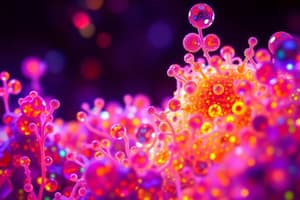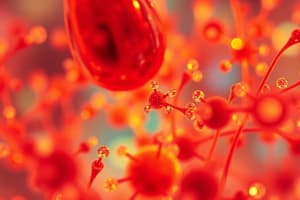Podcast
Questions and Answers
What is the primary method by which contrast in biological specimens is improved for light microscopy?
What is the primary method by which contrast in biological specimens is improved for light microscopy?
- Changing the lighting source
- Increasing the magnification
- Adjusting the condenser lens
- Applying stains to the specimen (correct)
What does the term 'resolution' refer to in light microscopy?
What does the term 'resolution' refer to in light microscopy?
- The depth of field in microscopic images
- The clarity of an image or the ability to distinguish detail (correct)
- The total magnification ratio of the lenses
- The ability to transmit light without distortion
What is the practical limit to magnification with a light microscope?
What is the practical limit to magnification with a light microscope?
- 1300 X (correct)
- 1000 X
- 1500 X
- 600 X
How is total magnification calculated in light microscopy?
How is total magnification calculated in light microscopy?
What happens when magnification increases beyond the practical limit with a light microscope?
What happens when magnification increases beyond the practical limit with a light microscope?
What role does the condenser lens play in light microscopy?
What role does the condenser lens play in light microscopy?
What is the effect of applying stains to specimens during microscopy?
What is the effect of applying stains to specimens during microscopy?
What does the resolving power indicate in light microscopy?
What does the resolving power indicate in light microscopy?
What happens when light waves are out of phase by exactly one-half wavelength?
What happens when light waves are out of phase by exactly one-half wavelength?
Which method is appropriate for cleaning microscope lenses?
Which method is appropriate for cleaning microscope lenses?
What is a fluorescence microscopy primarily used for?
What is a fluorescence microscopy primarily used for?
What should you do first when setting up a microscope?
What should you do first when setting up a microscope?
How can contrast be enhanced in microscopy?
How can contrast be enhanced in microscopy?
What is the function of the iris diaphragm in microscopy?
What is the function of the iris diaphragm in microscopy?
When cleaning an ocular lens, what is the recommended technique?
When cleaning an ocular lens, what is the recommended technique?
What is a crucial consideration when raising the substage condenser?
What is a crucial consideration when raising the substage condenser?
What is the primary purpose of adjusting the fine focus on a microscope?
What is the primary purpose of adjusting the fine focus on a microscope?
What should be done before advancing to a higher magnification objective?
What should be done before advancing to a higher magnification objective?
What is a critical step when using a binocular microscope?
What is a critical step when using a binocular microscope?
Why is it important not to rotate the nosepiece excessively while changing objectives?
Why is it important not to rotate the nosepiece excessively while changing objectives?
What is the purpose of the oil-immersion lens?
What is the purpose of the oil-immersion lens?
What adjustment should be made to optimize illumination and contrast?
What adjustment should be made to optimize illumination and contrast?
When switching lenses, what is typically sufficient after changing lenses on a parfocal microscope?
When switching lenses, what is typically sufficient after changing lenses on a parfocal microscope?
What is the correct order of objective usage when viewing a specimen?
What is the correct order of objective usage when viewing a specimen?
What is the role of iodine in the Gram staining procedure?
What is the role of iodine in the Gram staining procedure?
What distinguishes Gram-negative cells during the decolorization step?
What distinguishes Gram-negative cells during the decolorization step?
What color do Gram-positive cells typically appear after the counterstaining process?
What color do Gram-positive cells typically appear after the counterstaining process?
Which statement best describes the decolorization process in Gram staining?
Which statement best describes the decolorization process in Gram staining?
What effect does the alcohol/acetone solution have on Gram-negative cell walls?
What effect does the alcohol/acetone solution have on Gram-negative cell walls?
What is the primary reason for using safranin in the Gram staining process?
What is the primary reason for using safranin in the Gram staining process?
What common error can lead to false results in the Gram stain process?
What common error can lead to false results in the Gram stain process?
What do the colors observed in the Gram stain indicate about the cells?
What do the colors observed in the Gram stain indicate about the cells?
What is the purpose of adjusting the field diaphragm during microscope setup?
What is the purpose of adjusting the field diaphragm during microscope setup?
What should be done after adjusting the field diaphragm for optimal image quality?
What should be done after adjusting the field diaphragm for optimal image quality?
Why should the specimen be focused at low power before making other adjustments?
Why should the specimen be focused at low power before making other adjustments?
What is observed when the field diaphragm is completely closed?
What is observed when the field diaphragm is completely closed?
What happens as you raise and lower the condenser while observing light fringes?
What happens as you raise and lower the condenser while observing light fringes?
What adjustment must be made for each objective lens in microscopy?
What adjustment must be made for each objective lens in microscopy?
Why is it important to use the lower-power objectives when centering the specimen?
Why is it important to use the lower-power objectives when centering the specimen?
What is the first step to take once the lamp is turned on during microscope setup?
What is the first step to take once the lamp is turned on during microscope setup?
Flashcards are hidden until you start studying
Study Notes
Light Microscope Theory
- Bright-field microscopy creates images using transmitted light through a specimen, resulting in a shadowy appearance against a bright background.
- Contrast in biological specimens, often transparent, is enhanced by staining, although stains typically kill cells.
- Total magnification formula: Total Magnification = Magnification by Objective Lens x Magnification by Ocular Lens.
- Practical limit for light microscope magnification is around 1300X; clarity diminishes at higher magnifications.
- Resolution, the ability to distinguish between two points, improves as the limit of resolution decreases.
Image Formation
- Light from an internal or external source passes through the condenser lens, allowing uniform illumination.
- Refraction of light as it travels through the objective lens produces a magnified image.
- Contrast arises from differences in light intensity due to variations in refractive indices in the specimen.
Fluorescence Microscopy
- Utilizes fluorescent dyes to emit light when exposed to ultraviolet radiation; some specimens naturally fluoresce.
Basic Operation of Microscope
- Carry microscope properly: one hand on the arm, other supporting the base.
- Begin with adjusting the substage condenser and opening the iris diaphragm for appropriate illumination.
- Use the nosepiece to switch between objectives without damaging lenses; focus specimen accordingly.
- Adjust the iris diaphragm and field diaphragm to optimize illumination.
Adjustments for Examination
- Center the condenser using centering screws for precise illumination.
- Open field diaphragm until it almost fills the view field, making final adjustments for clarity.
- For non-bacterial specimens, use increasing magnification by switching objectives, using fine focus as necessary.
Gram Staining Technique
- Crystal violet stains both Gram-positive and Gram-negative cells; iodine acts as a mordant.
- Decolorization with alcohol or acetone removes the primary stain from Gram-negative cells, allowing for counterstaining with safranin.
- Gram-positive cells retain crystal violet due to their thicker peptidoglycan layer, appearing violet, while Gram-negative cells turn pink/red from safranin.
Sources of Error in Gram Staining
- Poor technique may lead to false results; for example, under-decolorization can cause Gram-negative cells to appear Gram-positive.
- Inconsistent emulsion preparation can also affect staining results.
Studying That Suits You
Use AI to generate personalized quizzes and flashcards to suit your learning preferences.




